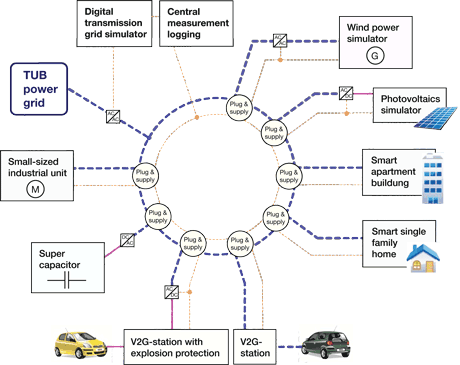by Kai Strunz and and Christian Wiezorek
The transition towards increasingly renewable energy systems calls for novel techniques of operation and control in response to the changing power transmission and distribution networks. A Smart Grid is expected to efficiently manage supply and demand of electricity. Electric networks will become more intelligent, bringing the worlds of IT, communications and energy systems closer together than ever before. The EIT ICT Labs, one of the Knowledge and Innovation Communities (KIC) at the European Institute of Innovation and Technology (EIT), are strongly supportive of work in this area. Founded in 2008, EIT aims to create synergies between education, research, and innovation. It promotes the systematic development of international networks and clusters of excellent institutions, universities and industrial research centres in Europe. Six nodes of the EIT ICT Labs across Europe coordinate different thematic topic areas. The action line “Smart Energy Systems” – located at the Berlin Node – addresses the above-mentioned synergies of ICT and energy systems.
One of the activities coordinated within “Smart Energy Systems” is the European Virtual Smart Grid Laboratory (EVSGL). This activity develops a virtual lab integrating the expertise and capacities of each partner’s lab resources, thereby creating a platform with a wide-ranging application field in terms of information exchange and personnel involvement (see Figure 1). Involved are highly renowned universities such as KTH Stockholm, Imperial College London, TU Delft, TU Berlin and excellent research centres such as the Technical Research Center of Finland (VTT), the Dutch National Research Institute for Mathematics and Computer Science (CWI), the German Research Center for Artificial Intelligence (DFKI), and several institutes of the Fraunhofer Gesellschaft. Industry partners, including Ericsson and Siemens, also participate. Each partner contributes its expertise in its particular field to joint projects. As a key project, the setup of the virtual laboratory consists of three sequential stages:
- Initialization stage: In the first stage, the fields of competences of each partner are discussed and put into context with those of the other partners to identify complementary expertise.
- Connection stage: During the second stage, the technical groundwork for the connection of the involved labs is laid. Demonstrators prove the functionality. At the end of this stage, first experiments at the labs can be observed by partners from remote sites.
- Implementation stage: Within this stage, the successfully implemented network will be used to run the Virtual Smart Grid Lab.

Figure 1: the European Virtual Smart Grid Laboratory

Figure 2: the Smart Grid Laboratory at TU Berlin
The European Virtual Smart Grid Lab activity is led by the Chair of Sustainable Electric Networks and Sources of Energy (SENSE) at TU Berlin [1]. At SENSE, the Smart Grid Laboratory at TU Berlin has been established, integrated within EIT, and first presented at the 3rd IEEE PES Innovative Smart Technologies (ISGT) Europe 2012 conference from 14 to 17 October 2012 in Berlin [2]. The laboratory comprises real power hardware with a low voltage distribution feeder integrating different load, storage, and generation components (see Figure 2). Various smart control schemes are applied. This includes operation in the form of a microgrid. In addition, a real-time digital simulator serves for reproducing a possible connection to the transmission grid. A main scope of study of the TU Berlin Smart Grid Lab is the integration of renewable energy and electromobility into the power system.

Figure 3: the physical structure of the lab
The physical structure of the lab is shown in Figure 3. The plug-and-supply interfaces to which resources can be connected are marked in green. Starting from the feed-in, the ring connects a solar photovoltaics (PV) simulator shown in blue. It consists of a commercially available inverter and a solar panel emulated by a controllable electronic amplifier. Loads are shown in yellow. A single family home and an apartment building consist of both off-the-shelf appliances such as dishwashers, refrigerators, and boilers, and electronic loads. A small industrial unit is represented by different electronic loads capable of providing machinery load profiles. Two electric vehicle-to-grid (V2G) charging stations are shown in cyan, one of which is for e-bikes. The simulator for a distributed wind energy conversion system consists of a motor-generator unit. The protective container allows for the integration of battery, super capacitor, and cache control testing [3], [4], as indicated in purple. As a part of the Virtual European Smart Grid Laboratory, the installation will support the development of Smart Grid solutions in Europe and beyond [2].
References:
[1] TU Berlin SENSE:
http://www.sense.tu-berlin.de
[2] IEEE PES ISGT Europe 2012: http://www.ieee-isgt-2012.eu
[3] K. Strunz, H. Louie: “Cache energy control for storage: Power system integration and education based on analogies derived from computer engineering”, IEEE Transactions on Power Systems, Vol. 24, No. 1, pp. 12-19, February 2009
[4] H. Louie, K. Strunz: “Superconducting magnetic energy storage (SMES) for energy cache control in modular distributed hydrogen-electric energy systems”, IEEE Transactions on Applied Superconductivity, Vol. 17, No. 2, pp. 2361-2364, June 2007
Please contact:
Kai Strunz
Technische Universität Berlin, Germany
E-mail:











